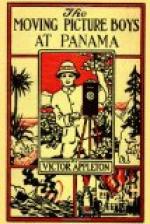A boat comes along until it reaches the place where the lock is. It is floated into a basin, or section, of the waterway, and a gate is closed behind it. Then, from that part of the canal which is higher than that part where the boat then is, water is admitted into the basin, until the boat rises to the level of the higher part of the canal. Then the higher gate is opened, and the vessel floats out on the higher level. It goes “up hill,” so to speak.
By reversing the process it can also go “down hill.” Of course there must be heavy gates to prevent the higher level waters from rushing into those of the lower level.
Some parts of the Panama Canal are eighty-five feet higher than other parts. In other words, a vessel entering the Canal at Colon, on the Atlantic side of the Isthmus, must rise eighty-five feet to get to the level of Gatun Lake, which forms a large part of the Canal. Then, when the Pacific end is approached, the vessel must go down eighty-five feet again, first in one step of thirty and a third feet, and then in two steps, or locks, aggregating fifty-four and two-thirds feet. So you see the series of locks at either end of the great Canal exactly balance one another, the distance at each end being eighty-five feet.
It is just like going up stairs at one end of a long board walk and down again at the other end, only the steps are of water, and not wood.
The tug bearing Blake, Joe and Mr. Alcando was now steaming over toward Toro Point break-water, which I have before alluded to. This was built to make a good harbor at Colon, where violent storms often occur.
“I want to get some pictures of the breakwater,” Blake had said, since he and his chum were to present, in reels, a story of a complete trip through the Canal, and the breakwater was really the starting point. It extends out into the Caribbean Sea eleven thousand feet.
“And you are taking pictures now?” asked Mr. Alcando, as Blake and Joe set up a camera in the bow of the boat.
“That’s what we’re doing. Come here and we’ll give you lesson number one,” invited Blake, clicking away at the handle. “I will gladly come!” exclaimed the Spaniard, and soon he was deep in the mysteries of the business.
There was not much delay at the breakwater, as the boys were anxious to get to the Canal proper, and into the big locks. A little later their tug was steaming along the great ditch, five hundred feet wide, and over forty feet deep, which leads directly to the locks. This ditch, or start of the Canal proper, is about seven miles long, and at various points of interest along the way a series of moving pictures was taken.
“And so at last we are really on the Panama Canal!” cried Joe as he helped Blake put in a fresh reel of unexposed film, Mr. Alcando looking on and learning “points.”
“That’s what you are,” the captain informed them, “and, just ahead of you are the locks. Now you’ll see something worth ‘filming,’ as you call it.”




